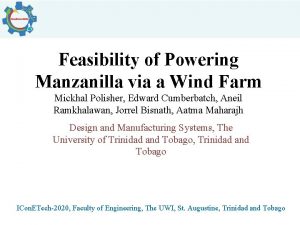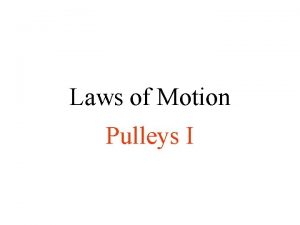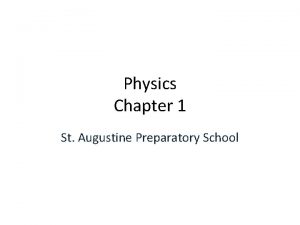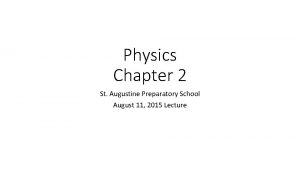Physics Chapter 4 Pulleys St Augustine Preparatory School












- Slides: 12

Physics – Chapter 4 Pulleys St. Augustine Preparatory School October 19, 2015

Pulleys

Solving Pulley Questions • To solve pulley questions, both the force of gravity (Fg) and the net force (Fnet) are going to be important. In the situation on the right, which mass do you think will drop and which one will be pulled up? Why?

Pulley Question Number 1 Given two masses, 5 kg and 3 kg, calculate the net force of the system, as well as the acceleration of the system. Assume that the rope has no mass and the pulley is frictionless.

Solution a. Net Force: Fnet = Fg, m 2 – Fg, m 1 Fnet = m 2 g – m 1 g Fnet = (5. 00 kg)(-9. 81 m/s 2) – (3. 00 kg)(-9. 81 m/s 2) Fnet = -19. 62 N = -19. 6 N b. Acceleration of the system (using Fnet = ma) a = Fnet/m a = (-19. 6 N) / (5. 00 kg + 3. 00 kg) a = -2. 45 m/s 2

Pulley Question Number 2 A 10. 0 g mass is tied to a string. The string is attached to a 500. 0 g mass and stretched over a pulley, leaving the 10. 0 g mass suspended above the floor. Determine the time it will take the 10. 0 g mass to fall a distance of 1. 50 meters if starting from rest and the surface is frictionless. (hint: frictionless therefore Fnet = Fg. Also d = vit + ½ at 2 )

Solution Step 1: Calculate Fnet = mg = (0. 010 kg)(-9. 81 m/s 2) = -0. 0981 N Step 2: Calculate the acceleration of the system a = Fnet/m = -0. 0981 N/(. 500 kg + 0. 010 kg) a = -0. 192. . m/s 2 Step 3: Calculate time to fall 1. 50 m using kinematics formula (d = vit + ½ at 2, assuming vi = 0. 0 m/s) d = vit + ½ at 2 can be rearranged and solved as

Try on your own… • Consider the two-body system shown below. There is a 0. 250 -kg object accelerating across a rough surface. The sliding object is attached by a string to a 0. 100 kg object which is suspended over a pulley. The coefficient of kinetic friction is 0. 183. Calculate the acceleration of the boxes. (hint: Fnet = Fg – Ff)

Solution: 1) Find Fg for the hanging mass Fg = mg = (0. 100 kg)(-9. 81 m/s 2) = -0. 981 N 2) Find Ff for the block on the table. This block will oppose the motion of the falling block. Remember, FN will be equal and opposite to the force of gravity Fk = u. FN = (0. 183)(9. 81 m/s 2)(0. 250 kg) = 0. 4488…N 3) Find the net force Fnet = Fg + Fk = -0. 981 N + 0. 4488. . N = -0. 53219. . N 4) Find the acceleration using the mass of both boxes a = Fnet / m = -0. 53219. . N / 0. 350 kg = -1. 52055 m/s 2 a = -1. 52 m/s 2

Applying both pulley’s and inclined planes Two boxes are connected by a string that runs through a frictionless pulley. If M 2 has a mass of 15 kg, M 1 has a mass of 9. 0 kg, the coefficient of static friction is 0. 150, and the inclined plane has an angle of 20 degrees, calculate the acceleration of the boxes.

Solution Step 1: Calculate Fg of the hanging box Fg = mg = (15 kg)(-9. 81 m/s 2) = -147. 15 N Step 2: Calculate Fk for the box on the inclined plane (this requires us to calculate the normal force, which requires us to calculate the force of gravity perpendicular. Note: I used + for perpendicular, since I was unable to find an upside down T) a. Fg+ = Fgcos(θ) = (9. 0 kg)(-9. 81 m/s 2)cos(20°) = -82. 965…N From this, we now know that the normal force is 82. 965…N b. Fk = u. FN = (0. 150)(82. 965…N) = 12. 444…N Step 3: Calculate the net force Fnet = -147. 15 N + 12. 444…N = -134. 705…N Step 4: Calculate the acceleration using the mass of both boxes a = Fnet / m = -134. 705. . N / (15. 0+9. 0)kg = -5. 6127 m/s 2 a = -5. 6 m/s 2

Things to remember… • Net force is found by finding the force of gravity on the more massive box and subtracting the force of gravity on the less massive box • The two boxes have to have the same acceleration since they are connected – This means that to calculate the acceleration, you must use the mass of both boxes – Fnet = (m 1 + m 2)a, where m 1 and m 2 are the masses of the two boxes























